This article deals with pith helmets which were specially made for female customers. Is this an issue for the Military Sun Helmets website? Yes. However, the subject is not pith helmets as they were issued to female medical or communications/clerical staff in the armies of several countries. Rather, it deals with the often difficult distinction between helmets for men and for women, something that should be useful knowledge for the military collector as well.
For the line between military and civilian pith helmet models is often blurred – as well a civilian helmet may have had a military past because in many theaters of war, next to the helmets issued officially, everything available was worn. In turn, within civilian models, the transition between models for men and women is fluid as well. Less at the beginning of the 20th Century, before the First World War, but increasingly from the 1920s to the 1950s, when the fashion lost many of their gender characteristics and pith helmet models became almost unisex. This article tries to point out some of the differences.
Hans von Donnersmarck, a German officer, traveled to India in 1908 and attended a ball in Bombay (Mumbai). He observed female participants in clothing which followed the latest fashion from Paris. Even if certainly more suitable “everyday use” tropical clothing was worn by ladies in remote posts in the colonies, they orientated themselves on what was shown on the catwalks of European fashion capitals, when they resided in the social centres of the overseas possessions. These fashions are reflected in the design of pith helmets. As huge hats were fashionable in Europe before First World War, corresponding models were worn in the tropics. 1 Here are some examples:
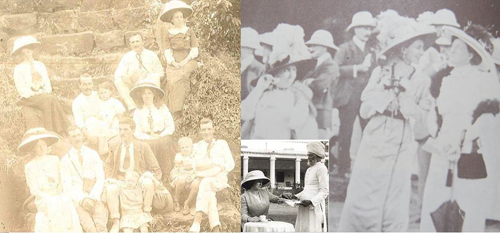
Three pictures from the period before the First World War: Ladies at social events in the tropics. No wonder that these hats were known at that time as “cartwheel hats”! The picture on the right is from Plain Tales from the Raj. 2
Here is such a cartwheel hat in reality, made or retailed at Silvio Sesti in Cairo. Amazing, though the huge hat with a diameter of 45 x 47 cm is made of pith, it is not actually heavier than a pack of cigarettes. The underside is covered with bright green wild silk. An important detail is the fact that there is no button on top, but only a kind of slotted ventilator. The strap of course has XXL size too. (Author’s collection)
What a diameter of 45 cm means becomes clear when compared to a regular Wolseley. The hat of Silvio Sesti, Cairo, is located under the Wolseley. In the picture on the right on top of it, in the middle, is the next cartwheel hat example, made be Hoar & Co. Bombay. (Author’s collection)
Also made of pith, also lighter than it seems, almost circular with a diameter of 35 cm, this hat, delivered from Hoar & Co in Bombay, has as well a ventilator cap with holes instead of a button. The white spots under the brim are insect damage. Typically as on the old pictures above, the brim is pulled far down, resembling a mushroom. (Author’s collection)
The third and last of the giants is 37 cm in diameter. Interesting is the almost square shape and the material used. This helmet of Woodrow, Piccadilly, London, is made of cork and thus brings it to as much weight as a Royal Marines Wolseley helmet with all its brass applications! Once again, the top does not have a button, but the small holed ventilator cap. The sweat band is not leather, but made from the silky material of the cover – including some decorative stitching. Remains of an attached wide black rubber band can be seen lying on the brim. (Author’s collection)
The three examples shown can quite safely be dated to the period before the First World War, according to photographs. These hats are rare, and all of this fashion that the author has encountered since 1980.
After the end of the First World War, in the “golden” 1920s, fashion changed rapidly. Many details became more masculine. Women wore trousers and often wore their long hair in a bob. Also at this time, for sure, such hat giants were still occasionally worn. But also, as already stated, women before the First World War not only wore cart wheel hats, but on other occasions, so to speak, “off-road”, more suitable headwear. Maybe like this example?
Slightly smaller than a Wolseley and difficult to date exactly, this hat from “London Hat Manufactory. Grande Maison du Congo, H. Leunis & Cie, Bruxelles ” is a blend of style elements of a tropical helmet and a summer hat for European latitudes. Very stylish: the curved seams on top! The dome is stiff – perhaps wicker? The brim is flexible – like a Panama hat – and covered with fabric. The holders for the sweat band – also of fabric – are made of rolled silk. A bit of tiny little rubber band to fix the hat has remained. (Author’s collection)
However, looking at pictures from the aftermath of the First World War, it is clear that helmets for men and women now differed only in details – compared to some pre-war examples. This is also visible in a contemporary department store catalog, the Army & Navy Stores edition of 1930/1931.
Straw hats were apparently, independent of fashion, always popular. In addition, a men´s cork helmet is offered here – which is also available for women: “Also for Ladies”! The pith helmet had indeed become unisex around 1930. Interesting detail: the model both for children as well as the “Lady’s Pith Helmet” miss the top button, but the mesh ventilator, as seen on the cartwheel hats – clearly feminine – is recognizable. Is this mesh therefore an indication of a ladies helmet that remained unchanged?
Here are two more examples:
This cartwheel ventilator topped helmet, produced by Scott, Bond Street, London, came from the estate of a Frenchman, Mr. A., who worked, according to a statement of his grandson, in Morocco until 1956. The helmet was worn there, in the 1920s, by his wife. The inside is worn, the initials of the family are but still clearly visible, as are the words “Importée d’Angletaire” – “Imported from England.” The pictures do not really catch the unusual shape of the helmet, which is indeed rounded like a pear. The author has not yet seen another example of this kind. (Author’s collection)
Hard to read on the faded label: “Wha Kung. Best sunhat.” Manufactured or sold by a dealer in Shanghai. Also here is a slotted ventilator to the top. Interesting to note is the use of different colors of fabric. Despite the fact that the present state, of course, is slightly soiled, the brim once has been white, the upper part and the Puggaree were cream. La dernier cri from Shanghai? (Author’s collection)
Besides the small mesh/slotted ventilators on top the use of white leather straps could be another indication that a helmet was intended for female clients. Taking a closer look, one realizes that helmets use mainly brown leather – white straps are comparatively rare. Here are two examples of white leather straps:
This helmet made by “FR” was retailed by Maison Romoli in Algiers. Rather small, this helmet has white leather applications. Female? (Author’s collection)
“British Made” – for British Maid? A helmet with the typical suspension of the head band, as patented by today´s still existing Scottish producer Owen. Again, white leather, but in another respect the only example of its kind known to the author with red lining under the brim! A fashionable variation for the female market or another implementation of the finding that the red color absorbs the sun’s rays better? Similar to the red fabric of helmets and caps of the Africa Corps, or the quilted red cloth, which were used with British uniforms neck pad? (Author’s collection)
These were some reflections and speculations on the question, how to distinguish models for men and women amongst civilian tropical helmets. Here one or more details must surely be clarified. Perhaps the readers of this site can add further information?
This is also true for the two interesting pieces to finalize this article. The feeling is, that they were rather done for women – but that cannot be proved. Nevertheless, they are – and that is also a criterion, according to the author – simply beautiful examples of sun helmets.
This helmet is made of straw with a cloth lining, the condition of which, despite the fragile material, fortunately is very good. Definitely a very fashionable piece – imagine, the yellow puggaree with a matching dress! (Author’s collection)
Small and cute, little bit chalked, this helmet, brand “Casque au Lion”, from Saigon, recalls, of course, immediately the later models of the Vietnamese army. However, note the envelopment of the brim, a material that reminds of ribbons – and of course to female accessories.
Roland Gruschka
- von Donnersmarck, Hans, Die Engländer in Indien, Berlin, 1909
- Allen, Charles, Plain Tales from the Raj, Futura Publications Limited, London, 1975

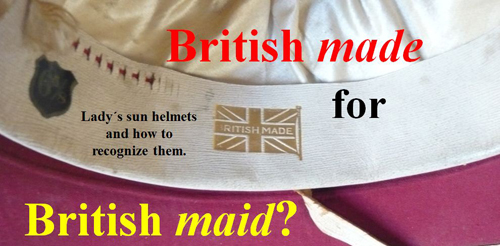
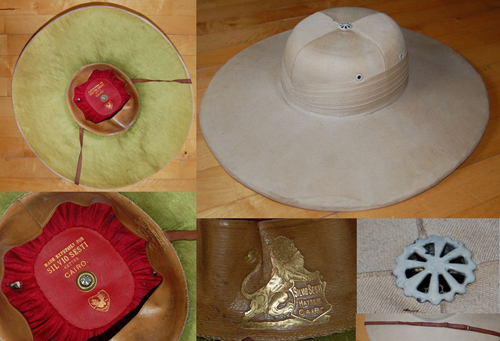
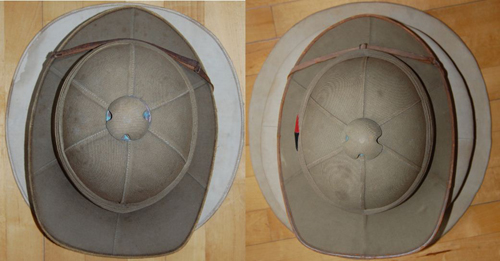
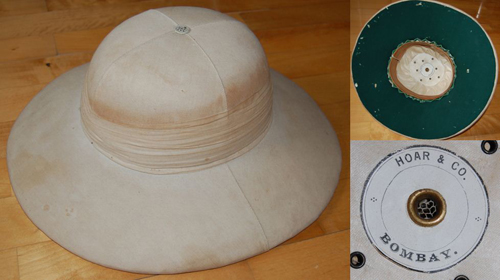
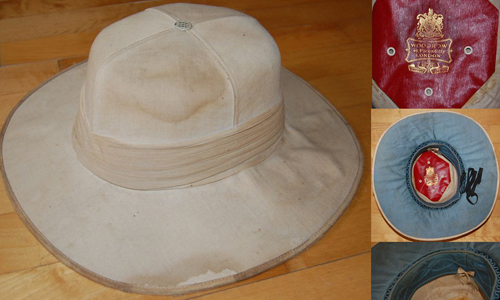
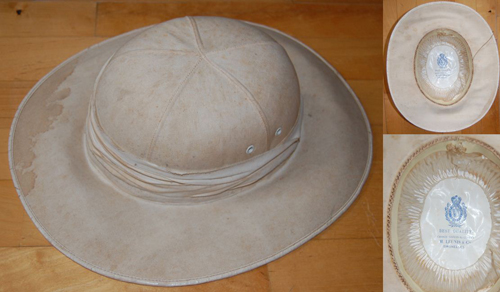
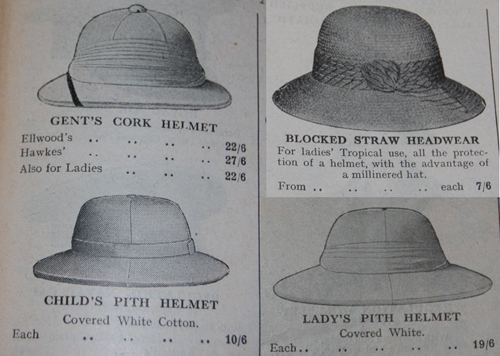
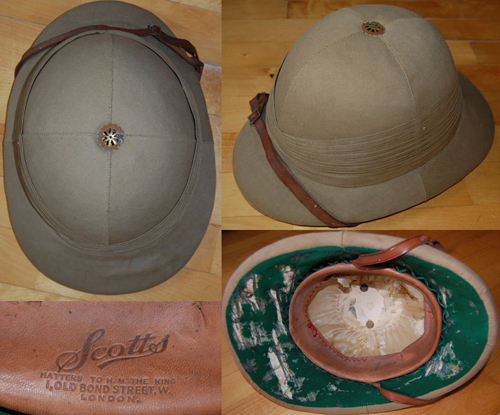
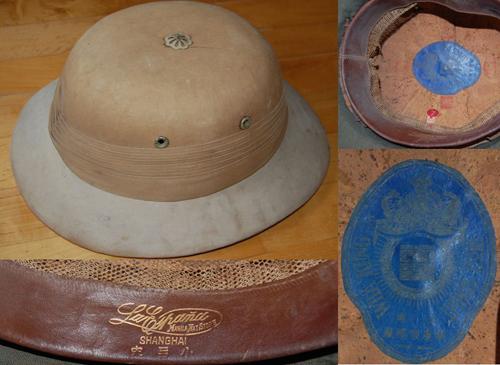
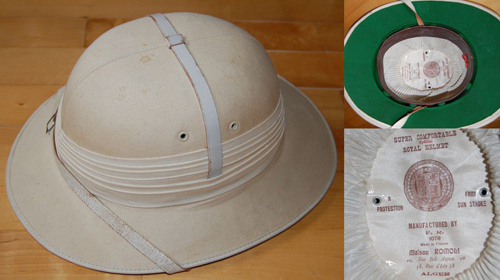
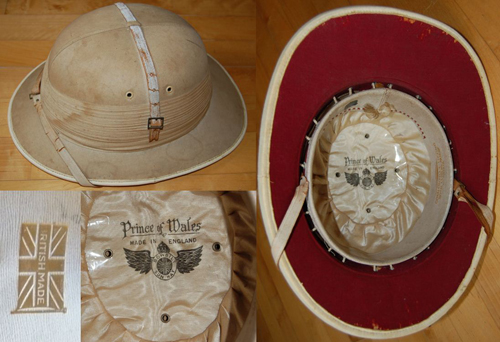
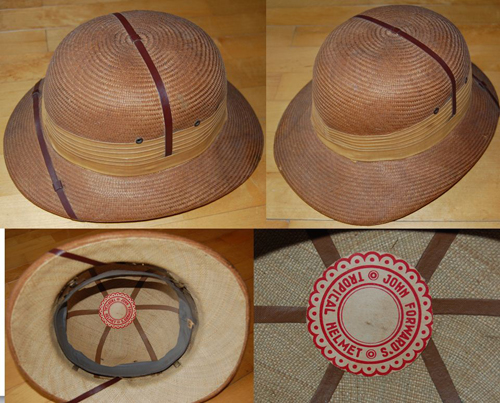
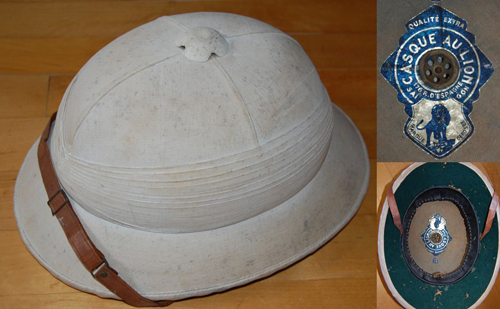
This is indeed a marvelous website. Dedicated to the most iconic material of the last century. I saw old pictures of my grandparents donning this, and has in fact also awaken my curiosity to it to the point of fetish. I don’t recall a day not thinking about it ( the pith hat) and hypothesize on how to make myself one with homemade materials. Coming from a tropics myself, I dream of enterprising myself with this merchandise as a sole product. Dreaming is free anyway.
To date, I collect casually, from some vietnamese variants to filipino gourd helmets that is a novelty.
I suppose I salute you fellows for bringing the appreciation to this height. I really enjoyed the postings so much I lost track of the days time.
“I saw old pictures of my grandparents donning this, and has in fact also awaken my curiosity to it to the point of fetish. I don’t recall a day not thinking about it ( the pith hat) and hypothesize on how to make myself one with homemade materials.”
http://i3.kym-cdn.com/entries/icons/facebook/000/014/285/not.jpg
WHERE IN THE WORLD CAN I PURCHASE THE “PITH HELMET TYPE” THAT WAS WORN BY THE BRITISH OFFICERS IN THE GHANDI MOVIE? THE HAT WAS WOLSELEY TYPE, WITH THE LONG BACK AND THE DOME WAS SORT-OF-ROUND-BUT-TRIANGULAR SHAPED. I’M TALKING WITH REAL PITH. I HAVE WORN THE WOLSELY ALL MY LIFE BUT HAVE NEVER BEEN ABLE TO FIND “THAT STYLE” I AM TALKING ABOUT, FOR A BETTER DESCRIPTION, THE HATS WORN IN THE GHANDI MOVIE IN THE SCENE WHEN THEY SHOT ALL OF THE CIVILIANS WITH THE MACHINE GUNS AT THE OPEN PUBLIC MEETING THAT HAD THE WATER WELL AT THE SIGHT. SOMEONE JUST TOLD ME THAT IN PICALDILLY SQUARE THERE IS A STORE THAT HAS ALL THE MOVIE-PROPS FOR THE MOVIE INCLUDING THESE PITH HELMETS. PLEASE HELP. THANKS VERY MUCH. STEVE WILCOX—–MARFA, TEXAS, USA——EMAIL:chopperfive@sbcglobal.net and, 24/7 mobile: 915-539-3247—–THANKS AGAIN.